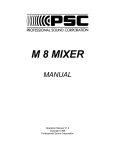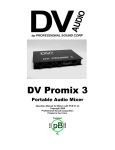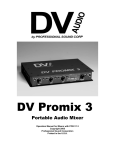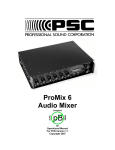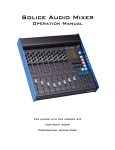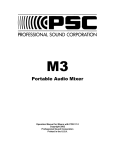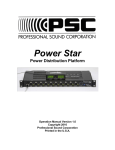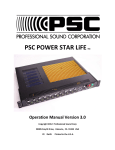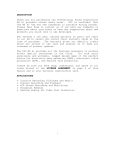Download PSC M6 Retro Specifications
Transcript
M6 Retro Portable Audio Mixer Operation Manual for Mixers with PCB V1.1 Copyright 2002 Professional Sound Corporation Printed in the U.S.A. TABLE OF CONTENTS DESCRIPTION……………………………………………………………………………4 SAFETY WARNINGS……………………………………………………………………4 APPLICATIONS…………………………………………………………………………..4 FUNCTIONS INPUTS……………………………………………………………………………7 A. BALANCED INPUTS B. INPUT LEVELS C. MICROPHONE POWERING D. LOW CUT FILTER E. CHANNEL GAIN F. CHANNEL PANS G. AUX SENDS H. CHANNEL FADER OUTPUTS…………………………………………………………………………7-8 A. BALANCED OUTPUTS B. OUTPUT LIMITERS C. HEADPHONE OUTPUTS D. PRIVATE LINE E. BOOM COMMUNICATION F. TAPE RETURNS METERS…………………………………………………………………………….9 A. PEAK READING METERS 2 ADDITIONAL FEATURES…………………………………………………………9 A. SLATE MICROPHONE B. REFERENCE OSCILATOR POWERING………………………………………………………………………..9-10 A. INTERNAL BATTERY POWER B. EXTERNAL POWER CONSTRUCTION……………………………………………………………………10 A. CHASSIS B. ELECTRONIC TOPOLOGY C. ENVIRONMENTAL OPERATION INTERFACING………………………………………………………………………11 A. TO RDAT RECORDERS B. TO NAGRA RECORDERS WARRANTY AND NON-WARRANTY SERVICE…………………………………11 SPECIFICATIONS…………………………………………………………………….12 3 DESCRIPTION Thank you for purchasing the Professional Sound Corporation M6 Portable Audio Mixer. We are confident that this M6 Mixer has set new standards for portable mixer technologies and features while incorporating a timeless housing design. Please feel free to contact us if you have any comments or questions concerning your new mixer. Additionally, we invite you to share your suggestions for new products you would like to see developed. Professional Sound Corporation extends a one-year warranty on parts and labor to all M6 Mixer owners who return their warranty cards at the time of purchase. This warranty gives you specific rights, which are stated on the card, and enables us to keep you informed of product updates. The PSC M6 Mixer provides all the functions necessary to produce studio quality recordings in the field. It’s user friendly features, rugged design and sonic purity make the M6 Mixer perfect for feature film recording, remote broadcast, and many types of electronic field production (EFP). HEARING SAFETY WARNINGS: Please be sure that you have read this entire manual before operating this mixer. While special attention has been given to your safety and hearing protection, the operator determines proper and safe operating levels. Please note the following: Always turn down the headphone volume before plugging in your headphones. Always operate your headphones at the lowest practical level. Be especially cautious in unknown or widely varying environments. Remember, your ears are your livelihood. Turn it down! APPLICATIONS • • • • • Feature Film Sound Recording Location recording (Dialogue and Music) Digital Recording and Playback Broadcast remotes Desktop Mixing for Video Post Production 4 INPUTS: A. BALANCED INPUTS The PSC M6 Audio Mixer provides six input channels utilizing female XLR connectors. The studio grade input circuitry is transformer balanced for improved RF rejection and in-field practicality. The XLR connectors are wired as follows: Pin 1 shield (ground), Pin 2 Audio high (in phase), Pin 3 Audio low (out of phase). Balanced wiring enables longer cable runs without the worry of excessive noise due to nearby electromagnetic and radio frequency interference. These balanced inputs may be unbalanced if desired. Either pin 2 or 3 may be tied to ground (pin 1) to unbalance the inputs of the M6 Mixer. Note: The AES standard for unbalancing an XLR connector is to tie pin 3 to ground (pin 1). B. INPUT LEVELS The PSC M6 Mixer can accommodate a wide range in input levels. Microphone levels of all types can be handled as well as line level signals. The input range of the M6 Mixer is –60dBu to +4dBu. Thus the M6 is compatible with all forms of consumer and professional audio equipment. The input level switches are located on the front panel. These input level switches provide for two level settings: “M” Microphone level (0dB attenuation), and “L” Line level (50dB attenuation) This input level attenuation settings are used to correctly interface sources of varying levels to the M6’s preamplifiers. Correct level matching ensures maximum headroom and lowest possible noise floor. C. MICROPHONE POWERING The M6 Mixer can accommodate the most popular microphones used today. The microphone powering switches are located directly below the input XLR connectors. They can be switched to either Dynamic (D) or 48Phantom (48) or Tornador (12T). In the Dynamic position the mixer provides no microphone powering. This position is used with Dynamic Microphones, Line Level inputs and when using Wireless Receivers. In the 48 Phantom Position the mixer provides 48 volts DC to pins 2 and 3 of the XLR connector. 48PH microphones or simplex powered microphones with a range of 9 to 52 volts or 12 to 52 volts may be powered by the M6 Mixer. Pin 1 is shield to ground while pins 2 and 3 carry 48 volts DC. The term “phantom” is derived from the fact that there is no voltage potential developed across pins 2 and 3 thus a dynamic microphone transducer can be operated with 48PH turned on. However, most portable wireless receivers will not operate with 48PH turned on. We strongly recommend setting inputs to dynamic for use with all wireless systems. 5 Because of the PSC M6 Mixer’s “retro” design, we have included the 12T microphone powering. When set to 12T, 12 VDC is applied across pins 2 and 3. Pin 2 being positive and pin 3 being negative. This polarity is know as “standard phase” and is the excepted A.E.S. standard. Some older 12T microphones may have been wired as “Red Dot”. This is the reverse polarity of standard phase and is still in use by a small percentage of 12T microphones world-wide. Any “Red Dot” microphone can easily be converted to standard phase to bring it into the A.E.S standards of operation. If you own 12T microphones wired “Red Dot” and do not wish to change their wiring, you can still operate them from the PSC M6 Mixer by using a simple phase cable or phase barrel. PSC part numbers are as follows: FPSC0010C Phase Reversal Barrel FPSC1017 Phase Reversal Cable D. LOW CUT FILTERS Each input channel of the M6 Mixer is equipped with an active low cut (high pass) filter. These filters are activated via the three way switches located near the adjacent channel fader knobs. These filters will attenuate all frequencies below a preset frequency at a rate of 12dB per octave. When set at “20Hz”, frequencies below 20 Hz are effectively rolled off with the mixer operating at full frequency response. Optional low cut filter settings of 100Hz and 140Hz will roll off the frequencies below these figures at a rate of 12dB per octave (-3dB level at 100Hz and 140Hz respectively. Low cut filtering is important in location recording where wind noise can cause pre-amplifier overload. This effect can be minimized by switching the low cut filter setting to either 100Hz or 140Hz cutoff. The low cut filter switches are located on the front of the M6 Mixer. E. CHANNEL GAIN In order to limit noise and increase headroom, the channel gain controls are located in the feedback path of the pre-amplifiers. This provides continuously variable gain rather than just a decrease in channel output level when an overload situation occurs. This results in increased headroom and lower chance of signal clipping (severe distortion). These pots have an adjustment range of approximately 50dB. F. CHANNEL PANS The new M6 Audio Mixer contains signal routing pan pots. These pan pots are used to route the individual input channel’s signal to either the left or right summing buss or any combination in between. G. AUX SENDS: In addition to the two left and right summing busses, the M6 Mixer offers two additional auxiliary summing busses that can be used for aux sends to Comtek tm transmitters , Directors feeds, Video Assist audio feeds etc. Each input channel contains two auxiliary send pots that control the level from that individual input channel to the auxiliary busses. 6 H. CHANNEL FADER: The PSC M6 Mixer is equipped with traditional rotary knob faders. This “retro” design is ideal for field use as it is dust and dirt resistant just like your trusty old Sela mixer. Ya baby, it’s 1975 all over again! Typical operating range of the faders is from #4 to #9 position on the fader. OUTPUTS: A. BALANCED OUTPUTS The M6 Mixer contains very high quality custom-made audio output transformers. These transformers have been designed to provide wide bandwidth, low distortion and real-world ease of use. Transformers have been chosen over a transformerless design because of their inherent ability to interface with virtually any other device, especially RF based products. This is very important in this day and age in consideration of the frequent use of multiple RF receivers and transmitters. The PSC M6 Mixer contains three separate balanced outputs. These include Left Main output, Right Main Output and a third balanced output labeled as Video Assist. This output is switch-able to feed either Left, Right or a Mono Sum of left and right. The switch is located on the front panel of the mixer near the meter. B. OUTPUT LIMITERS. The limit threshold (activation level) is factory set at +3 on the meter. The limiters compress the signal at approximately 2.7 to 1 ratio. This is to say an increase of 2.7dB in input signal will result in only a 1dB increase in output signal. Output channel limiting is indicated by the front panel mounted red LED’s.. The M6 contains two separate limiters that are controlled by one front panel mounted switch. This switch has three settings: Off, Separate (S), and Ganged (G). In the off position, no limiting occurs. In the separate position, the limiters act independently of each other. This is especially useful when recording split tracks. I.E. interviewer and interviewee on separate channels. Thus, if one person un-expectantly raises their voice, that limiter will activate, but the other will not. In the ganged mode, both limiters are tied together and can be triggered by either input. This is useful in recording stereo as independent limiting would alter the stereo image. C. HEADPHONE OUTPUTS The Main or “Mixer” headphone output is located directly on the front edge of the mixer. This location was chosen to allow the operator to easily plug/unplug the phones from the M6 Mixer and other devices. The M6 Mixer’s headphone 7 amplifier circuitry is designed to drive virtually any headphone with an impedance rating of 32 to 600 Ohms. The headphone circuitry is controlled by the use of a front panel selection switch and a volume control. The rotary switches are used to control what the operator listens to. These choices include: Left channel to both ears, Right channel to both ears, normal Stereo, a Mono sum of the two channels, Auxiliary 1 and Auxiliary 2. There is second switch located on the right hand side of the front panel of the mixer and is used to control the “tape” or “direct” monitoring sources. This switch controls only the monitoring of the “mixers” headphones. The PSC M6 mixer also contains three additional headphone outputs labeled as “Director”, “Boom 1” and “Boom 2” These three headphone feeds also offer the same selection of monitoring choices with the exception of monitoring “tape” D. PRIVATE LINE: The two headphone feeds labeled Boom 1 and Boom 2 also are equipped with “Private Line” circuitry. This allows the mixer operator to speak directly to the boom operators via the slate microphone without the audio going out any other outputs such as the main outputs. This is helpful if the mixer operator is located out of sight of the boom operator. To use the “Private Line” function, you must simply press the private line button located on the front panel of the M6 mixer. The private line function will only operate as long as the button is pressed down. E. BOOM COMM: The M6 mixer also contains a complete duplex communication system built in. This system allows the mixer operator and boom operators to communicate freely with each other in a full duplex mode (similar to telephone conversation). The rear panel of the M6 mixer contains two “TT” (tiny telephone) connectors that are labeled Com 1 and Com 2. These connectors have two purposes. They provide a microphone input and corresponding pre-amplifier and also a logic signal input to control the comm function. The PSC Duplex communicator cables are similar to our standard duplex cables in that they provide a talent (boom) input as well as a boom operator headphone feed. In addition to these common features, they contain a built in microphone and push to talk switch. This microphone and push to talk switch are used when ever the boom operator wishes to speak to the mixer operator. Conversely, there is another comm switch located on the front panel of the mixer used by the mixer operator to communicate with the boom operator(s). When any of the comm switches is pressed, the communication system is activated. When the communication system is in use, the slate microphone is routed to the two boom headphone feeds and the two boom operators talk back microphones are routed to the mixers headphone feeds. As soon as the communication button(s) are released, all headphone monitoring functions return to normal. *SAFETY NOTE* ALWAYS TURN DOWN THE HEADPHONE VOLUME BEFORE PLUGGING IN YOUR HEADPHONES. 8 F. TAPE RETURN The M6 Mixer is equipped with tape returns used to monitor tape confidence heads from most any recording device. These tape monitor amplifiers can be adjusted to match the signal levels of most any device. These levels are adjusted using a small jewelers screwdriver (or “Greenie” screwdriver). The adjustment points are located on the bottom panel of the M6 mixer. The tape/direct switch is located on the upper right hand corner of the front panel. When set to ”D” (Direct) the phone amplifiers to monitor the mixers output signal. If switched to “T” (Tape), then the phone amplifies monitor the external source such as the RDAT recorders. PLEASE NOTE The tape returns are only available for the “Left”, “Right” and “Stereo” monitor settings. There is no tape return function for the “Mono”, “Aux 1” or “Aux 2” settings. METERS: A. PEAK READING METERS The M6 Mixer is equipped with a custom made LCD meter. We designed this meter to be easy to read. Because the most common use of this type of mixer is with RDAT’s, we designed the M6’s meters to emulate the peak reading attributes found on many RDATs. ADDITIONAL FEATURES: A. SLATE MICROPHONE The M6 Mixer is equipped with a slate microphone. This microphone is activated when the front panel “slate” momentary push button switch is pressed. The slate microphone allows the operator to put voice slates (notes) on tape for later reference. These are normally notes for editing tape. A level adjustment trim pot is located near the slate button on the M6 Mixer. Turning the adjustment clockwise will increase the slate microphone level. Turning the adjustment counter-clockwise will lower the level. B. REFERENCE OSCILLATOR The M6 Mixer is equipped with a reference oscillator used for setting of levels between the mixer and recorder. This known reference level is also used when transferring tape during editing. The M6’s oscillator operates at 440Hz at “0” on the meters. We have chosen 440Hz simply because it is much more pleasant in your headphones than the typical 1Khz used by other manufactures. We have used 440 Hz on our mixers for many years. The reference oscillator is equipped with a level adjustment trim pot located internally. This adjustment is factory calibrated and should not be adjusted without proper measurement equipment. POWERING: A. INTERNAL POWER, ALKALINE BATTERIES 9 Ten “D” alkaline batteries can power the M6 Mixer. These batteries are accessed via the battery door located on the side panel of the M6 mixer. When using alkaline batteries, you can expect 6 to 10 hours of operation under normal circumstances. Always observe correct polarity when installing batteries! Note: Never store your M6 Mixer for extended periods of time with alkaline batteries installed in the mixer. There is a possibility that the batteries may leak causing corrosion of the mixer. Battery leakage and the resulting corrosion damage is not covered under the M6 Mixer warranty. B. EXTERNAL POWER The PSC M6 Mixer can also be externally powered from any source of DC power from 10 to 16 VDC. Do not exceed 16VDC or mixer damage will result. Over voltage and the resulting damage is not covered under the M6 warranty. The mixer consumes approximately 10 watts of power over this voltage range. The external power connector is located on the rear of the mixer. Pin outs of this Male XLR 4 pin connector are as follows: Pin 4 (+) Positive Pin 1 (-) Negative This external DC input is protected from reverse polarity up to 6 amps. If you inadvertently connect external power of the incorrect polarity, the mixer will not be damaged, it simply will not power up. CONSTRUCTION A. CHASSIS The new M6 Mixer chassis has been designed for demanding field use. The complete chassis is formed from 0.125” aircraft aluminum. All punching is done on a computer controlled “Trump” rotary turret punch press for extreme accuracy. In addition, through careful design, we have managed to keep the overall weight of the M6 Mixer to 12 lbs. (5.4Kg) total. The mixers sheet metal is hand-formed using various press brake setups before the stainless steel threaded inserts (Pem Nuts tm) are pressed permanently into place. The housing parts are then Chem Film TM plated for superior corrosion resistance before being electro-statically coated with an epoxy powder coating. This powder coat paint is then baked on in an oven. Powder coating was chosen for its durability and environmental friendly characteristics. All silk-screening is printed sub-surface (below) a hardface lexan tm overlay. This process provides a silk-screened label that is virtually wear proof. The lettering will not wear off as on other mixers. B. ELECTRONIC TOPOLOGY The new M6 audio mixer was designed from a clean sheet of paper. It utilizes completely new circuitry designs based upon the latest advances in semi conductor technology. In addition, it features surface mount technology for reduced size and weight. 10 The M6 Mixer uses high quality transformers on its inputs and outputs. Transformer topology was chosen for its inherent ability to reject RF, thus making this new mixer perfect for use with multiple RF systems. This new design uses modern semi-conductors from Maxim, Linear Technology National Semiconductor and Burr-Brown to name but a few. These operational amplifiers, voltage regulators and precision voltage references feature low power consumption, low noise and low distortion. C. ENVIRONMENTAL OPERATION Your new M6 Audio Mixer has been designed to operate under extreme field conditions. The electronics have been designed to operate over a temperature range of -4 to 158 degrees Fahrenheit (-20 to +70C) less the affects on batteries. This in addition to the M6’s ability to operate under high humidity conditions makes it perfect for harsh field conditions. INTERFACING A: TO RDAT RECORDERS: The M6 Mixer can be interfaced to virtually any professional recorder via the standard XLR outputs. B: TO WIRELESS MICROPHONES: The M6 Mixer will easily accept the output signal from virtually any wireless receiver. It can accept microphone or line level signal via a simple switch setting. Please note that most wireless receivers are not compatible with 48PH or 12T mic power. You should always set the M6’s mic powering switch to “D” dynamic when using wireless receivers. WARRANTY AND NON-WARRANTY SERVICE In the unlikely event your M6 Mixer requires service it should be carefully packed and shipped prepaid to: Professional Sound Corporation Service Department 28085 Smyth Drive Valencia, CA 91355 USA PH 661-295-9395 FAX 661-295-8398 e-mail [email protected] Please call before shipping your mixer. We may be able to solve your problem via the phone. We are always willing to help you with your M6 Mixer 11 questions. Complete details of the PSC M6 Mixer warranty are given on the enclosed blue warranty registration card. If you did not receive one, please contact your local dealer or call us directly. SPECIFICATIONS Size: 14” W x 15” D x 2.25” H (35.5cm x 38.1cm x 5.7cm) Weight: 12Lbs. (5.4Kg) Temp Range: -4 to +158F (-20 to +70C) Batteries: 10x D Alkaline Case Material: 0.125” (3mm) Aircraft Aluminum Finish: Epoxy Powder Coat Overlays: 0.005” Hardface Lexan tm with Sub-surface Epoxy silk screening Global Gain: 80dB Freq. Response: 20-20Khz +/-1dB Signal to Noise: 131dB EIN 150 Ohms Distortion: 00.08% THD Low Cut Filter: 100Hz, 140Hz 12dB/Octave Mic Power: DYN, 12T, 48 PH Oscillator: 440Hz Limiter: 1mS Attack, 100 mS Release 2.7:1 Ratio Warranty: 1 Year, Limited Copyright 2002, Professional Sound Corp. This manual and the complete M6 Mixer design is covered under various state, federal and international copyright laws. No portion of this manual or any M6 mixer technologies may be reproduced without the specific written permission of PSC. All rights reserved. This manual and all M6 Mixer specifications subject to change without notice. 12












